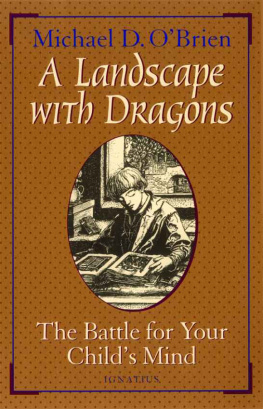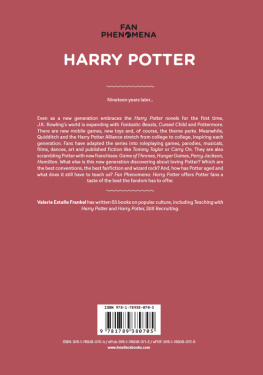A LANDSCAPE WITH DRAGONS
A LANDSCAPE
WITH DRAGONS
The Battle for Your Childs Mind

by Michael D. OBrien
IGNATIUS PRESS SAN FRANCISCO
First edition published by
Northern River Press
under the title
A Landscape with Dragons: Christian and
Pagan Imagination in Childrens Literature
Illustrations by H. J. Ford: pages
Albrecht Drer: title page, frontispiece,
Howard Pyle: page
Illustrations adapted from
H. J. Ford: pages
Eighteenth-century, artist unknown: page
Cover art by Howard Pyle
Cover design by Michael D. OBrien and Riz Boncan Marsella
1998 by Ignatius Press, San Francisco
All rights reserved
ISBN 987-0-89870-678-9 (PB)
ISBN 978-1-68149-012-0 (EB)
Library of Congress catalogue number 97-76843
Printed in the United States of America
For John, Joseph, Mary-Theresa, Elizabeth,
Ben, and Angela,
who taught me how to read .

Then war broke out in the heavens. Michael and his angels waged war upon the dragon. The dragon and his angels fought, but they had not the strength to win, and no foothold was left to them in heaven. So the great dragon was thrown down, the serpent of old that led the whole world astray, whose name is Satan, or the Devilthrown down to the earth and his angels with him.
Revelation 12:7-11
Dire warnings were come over the land of the Northumbrians and sadly terrified the people. There were tremendous lightnings and fiery dragons were seen flying in the air.
The Anglo Saxon Chronicle, A.D. 793
Contents
An Early Encounter
The Natural History Museum
The True History of the Universe
Just a Fairy Story?
Dragons in Myth, Legend, and Faerie
Answering the Critics of Fairy Stories
Culture and the Search for Truth
The Incarnation and the Image
The New Gnosticism
The New Illiteracy
Invasion of the Imagination
Vigilance, Paranoia, and Uncle Walt
Where Is It All Leading ?
Why Has the West Become Neopagan ?
Madeleine LEngles Christian Neopaganism
The Gray Zone
Some Notes on Spiritual Discernment
Tolkiens Middle-earth
C. S. Lewis Fantasy Novels
George MacDonald and the Baptized Dream
Picture Books
Easy Readers
Short Chapter Books
Books for Intermediate Readers
Adult Titles
Foreword
The last quarter of the twentieth century has witnessed a radical shift in the nature of literature. During previous centuries, as fiction in the Western world wrestled with the issues of life, it always did so from the experience of Christianity. An author may have supported or attacked the faith, but he would always have had to contend with it. That world is now rapidly changing. In the late nineteenth century and with increasing momentum in the early part of this century, a new yet ancient force began to press in to displace Christian principles from the realm of literature. That force is paganism.
A Landscape with Dragons is about the shift in culture from a Christian-based world view to that of a new and revised paganism. The author examines the difference between the two and shows how the pagan message is being packaged to appear as Christian writing. But he deals with far more than just the problem of deception. He is examining a major crisis in traditional culture.
OBrien uses anecdotes from his family life experiences, skillfully woven, insightful, and often amusing. He begins with a story of his own childhood nighttime fears and the wise way in which his mother helped him to overcome them. Having captured our attention, he then explores the fundamental struggle that every person encounters between courage and terror. At this point he introduces us to one of the most helpful subjects covered in the book: the role that fable plays in the development of the imagination and of a healthy world view. Focusing on Christian fantasy writing, he examines its important effect in the education of children. Choosing three major authors in this genre, J. R. R. Tolkien, C. S. Lewis, and George MacDonald, he proceeds to show how the greater body of their writing represents the constructive role that such literature can play in a childs development. He points out, however, a few details of their work in which they deviatedunintentionally, he believesfrom the proper employment of symbols. Despite their flaws, they stand in marked contrast to those authors whose misuse of Christian symbols is actually a thin disguise for a deep-seated paganism.
The author is concerned about the growing illiteracy of the Western world. He maintains that, without exposure to a literature springing from authentic spiritual sources, a society will be ill-equipped to detect the influences of false culture. Furthermore, it will be crippled in its effort to establish a healthy culture. OBrien argues for a return to the traditional role of the fairy tale and for a simultaneous development of new forms of literature. He believes that both movements can recapture the imagination of the present generation and that of generations to come.
The role of symbols is one of OBriens central concerns. The symbols employed in traditional storytelling signified real presences in the invisible world, be they angels or devils. They offered spiritual insight into the nature of the Christian cosmos, imparting to the child some essential insights into the invisible realm and the struggle between it and the natural realm where we must live. The book examines one image in particularthe dragon. The author describes how this symbol is common to almost all cultures in some form or other and how in Western literature it has represented the antagonist in a clearly defined battle between good and evil. The battle lines have become blurred because of a growing religious illiteracy and departure from traditional use of classical symbols. It is now widely held that dragons are merely misguided, in need of compassion, and in some cases misjudged altogether. The monster is being tamed.
This kind of reversal of symbolism constitutes an invasion of the imagination, undermining our ability to recognize truth. Because of mans vulnerability to the power of impressions, he is becoming less able to grasp reality itself. Good is no longer perceived as good, nor evil as evil; traditional Christian values are considered to be the product of a narrow-minded prejudice. This has led to a blend of human and diabolical concepts in the written word and, more recently, in cinema. A new world view is being propagated, one that attempts to convince the young that demons are friends or cuddly pets and that people can use evil means to achieve good ends. The author maintains that the growing confusion that has resulted draws modern man away from traditional Christian spirituality and prepares him to accept occult replacements.
OBrien goes beyond the written word to examine the power and mechanics of cinema and television and of the video phenomenon that is an offspring of the two. Although he does not dismiss the value of these media, he does make some cautionary notes about the way in which they affect the developing mind of the child and contrasts this with the effects of the written word.
He goes farther into some difficult territory when he addresses the problem of the new genre of films being produced for children. He gives special treatment to one of the most charming of all, the 1993 release of the story of Aladdin from Walt Disney Productions. This animated video appears at first glance to qualify as a valid fable according to the principles set forth in this book, but the author provides a thought-provoking insight into the way in which it departs from the traditional role of the fairy tale.
Next page








![J K Rowling - Harry Potter [Complete Collection]](/uploads/posts/book/117015/thumbs/j-k-rowling-harry-potter-complete-collection.jpg)




